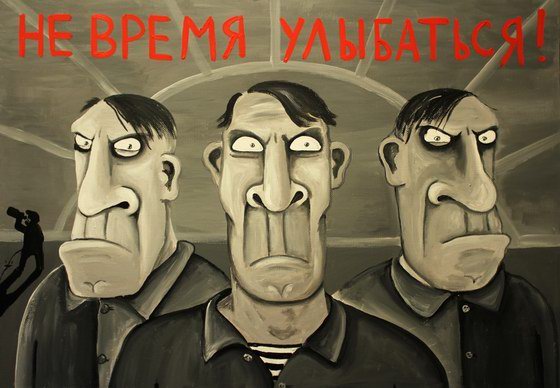Russian smile has national originality - it performs almost completely different, if not opposite functions than smile in Western European countries or the US.
From a European perspective, Russians are gloomy and unsmiling.
This is due to the phenomenon of everyday unsmiling of Russians - one of the most vibrant and nationally specific features of Russian non-verbal behavior and Russian communication in general.

“Not the time to smile”
Specific features of Russian smile:
Russian smile is usually performed only by lips.
Occasionally upper row of teeth becomes slightly visible. Smiling with demonstration of upper and lower teeth, as it is done by Americans, is considered in Russian culture unpleasant, vulgar, this smile is called a “horse smile.”Smiling is not a signal of politeness.
In American, English, German communicative behavior smiling is a signal of politeness, so it is required when greeting and during polite conversation.
Russian writers have repeatedly drawn attention to the difference between Russian and American smiles, describing American smile as strange and artificial for Russian people.
In Russian communicative behavior, “polite” smile is out of habit, and on the contrary - if “polite” smile is recognized as such, Russian people usually become wary or even begin to behave hostile. This “official” smile is considered a sign of person’s insincerity, unwillingness to show true feelings.Russians usually don’t smile to strangers.
Smile in Russian communication is addressed mainly to familiar people. That’s why saleswomen are not smiling to customers - they don’t know them. But they smile to customers they know.Russians don’t automatically give smile for smile.
If a stranger smiles to Russian, it encourages him to seek the cause of it.It is out of habit to smile to a person if you have accidentally caught his gaze.
In such cases, Americans smile and Russians on the contrary look away. Russians don’t necessarily smile together looking at small children or pets.Russian smile is a signal of personal sympathy.
That’s why Russians are smiling to persons they are familiar with. If you smile to a stranger, you can have the following reaction: “Do I know you?”Russians usually don’t smile while on duty.
Customs officers don’t smile as they are busy doing serious work, the same is true with sellers, waiters, etc. This is a unique feature of Russian smile. Also, it is unusual for children to smile during class. Russian adults teach children to be serious in school, or when talking to adults.Russian smile is a sincere expression of good mood or personal sympathy.
Smiling Russian person must have a good reason to do it.
In this case, a person gets its “right” to smile in the eyes of others. In Russian language there is a unique saying, which is absent in other languages - “Laugh for no reason is a sign of a fool” (if a person is laughing without a reason, something is wrong with his head).Russians usually don’t smile just to cheer up a friend, to do something nice for the other person, to support the person.
There is no clear distinction between a smile and a laugh.
These are the main features of Russian smile.

Everyday unsmiling of Russians (unsmiling but not gloom - Russian people are mostly funny, cheerful and witty) is also shown in Russian folklore, where we can find a lot of sayings and proverbs “against” laughing and joking:
- Jokes lead to no good
- Laugh for no reason - a sign of a fool
- There is no truth in jokes
- Laughter won’t feed you
- Do not believe the clown
And there are dozens of others with similar meanings.
Sincerity and openness are characteristic features of Russian communicative culture. There should be no special secrets from others. Hence - the habit not to hide person’s feelings.
For many centuries, everyday life was a severe struggle for existence. Deep concern became a normal mimicry of Russian person. Smiling in these circumstances reflects exception to the rule - welfare, prosperity, good mood.
Also, it should be noted that the market relations is an incentive nowadays. On the one hand, it can be an even greater concern for Russian people, and on the other hand - a stimulus to the appearance of a professional “commercial” friendliness that will influence this non-verbal component of Russian communicative behavior as a smile.
Sergei Rzhevsky (based on the article written by Yu.E.Prohorov, I.A.Sternin). Pictures by Vasya Lozhkin.

